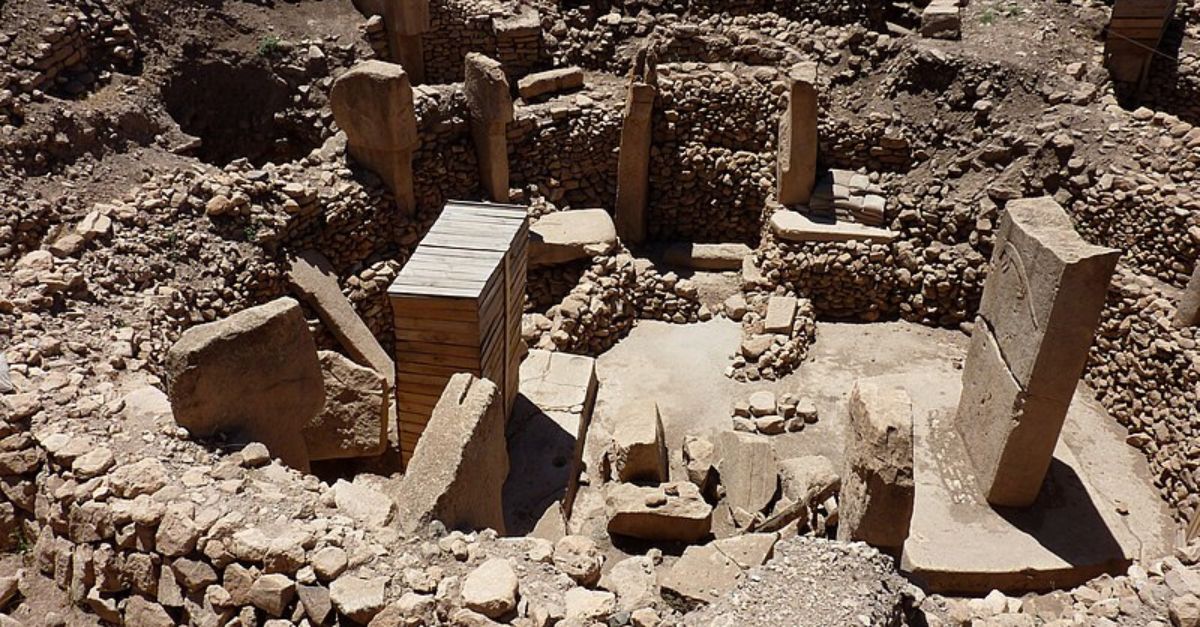More Than Metal
The clues weren’t in scrolls. They were buried in ash and clay. It turns out that some of the most powerful changes in history start with fire and the minds that manage it.

Archaeological Discovery
Deep in the heart of northern Benin, archaeologists uncovered something extraordinary that would rewrite West Africa's metallurgical history. The discovery happened during systematic surveys along the Niger River Valley, where researchers were mapping ancient settlements. What they found was evidence of sophisticated iron-smelting operations.
 Ironworking | Africa's Great Civilizations by Henry Louis Gates, Jr.
Ironworking | Africa's Great Civilizations by Henry Louis Gates, Jr.
Kompa Moussekoubou
The star of this archaeological revelation is none other than Kompa Moussekoubou, an iron-smelting site that stretches across 80 meters of terrain. Located approximately 60 kilometers northeast of Malanville, this area is strategically situated along seasonal waterways that once powered industries.
 Myassinekhatib, Wikimedia Commons
Myassinekhatib, Wikimedia Commons
Northern Benin
Northern Benin occupies a critical position in West Africa's ancient trade and technology networks. It straddles the Niger River, where multiple cultures converged for centuries. This region, also known as Dendi country, served as a crossroads between the Sahel and forest zones.
Niger Valley
The Niger Valley refers to the fertile region along the Niger River, one of West Africa’s waterways. It is about 4,180 kms (2,600 miles) long, flowing through countries such as Guinea, Mali, Niger, Benin, and Nigeria before emptying into the Atlantic Ocean.
 The Niger River, West Africa | DJI Mini 2 by Eboh Media
The Niger River, West Africa | DJI Mini 2 by Eboh Media
Niger Valley (Cont.)
This valley created the perfect environment for metallurgy, offering everything early ironworkers needed for successful operations. Seasonal flooding deposited rich alluvial soils, while nearby cliffs provided clay for furnace construction and ore deposits for raw materials. The Niger rises in the Fouta Djallon highlands of Guinea.
 The Niger River, West Africa | DJI Mini 2 by Eboh Media
The Niger River, West Africa | DJI Mini 2 by Eboh Media
Dendi Region
Dendi country represents one of West Africa's most important but understudied metallurgical regions. Here, multiple iron-working traditions developed and flourished simultaneously. This area witnessed the convergence of different technological approaches, with some communities using reusable furnaces with tapped slag.
 YoTuT from United States, Wikimedia Commons
YoTuT from United States, Wikimedia Commons
Dendi Region (Cont.)
However, others employed non-reusable furnaces with internal slag retention. The area's cultural diversity fostered innovation, as different ethnic groups shared knowledge and techniques, giving rise to a wide variety of metallurgical practices that influenced iron production across the continent.
 [NO COMMENT] Dendi Cultural Week by Studio Kalangou
[NO COMMENT] Dendi Cultural Week by Studio Kalangou
Origins
The Dendi trace their origins to the Songhai Empire of the sixteenth century and the earlier kingdom of Za. Oral traditions and chronicles, such as the Tarikh al-Sudan, document their early history. After the fall of the Songhai Empire, Dendi became a separate kingdom.
Dendi People
These folks are known for their patrilineal society, noble castes, and traditional marriage practices aimed at maintaining lineage purity. Their settlements often feature round, mud, or thatched dwellings, though rectangular mud-brick houses with tin roofs are increasingly common.
 C. Hugues https://www.flickr.com/photos/chugues/, Wikimedia Commons
C. Hugues https://www.flickr.com/photos/chugues/, Wikimedia Commons
Radiocarbon Dating
Scientific dating methods, primarily radiocarbon analysis of charcoal samples collected from furnace interiors and waste heaps at Kompa Moussekoubou, have established that the site’s major iron-smelting activities occurred between 900 and 1150 AD. These calibrated dates place Moussekoubou firmly within the period of Africa’s medieval metallurgical expansion.
 The Radiocarbon Dating Process: the Journey of a Sample by University of Oxford
The Radiocarbon Dating Process: the Journey of a Sample by University of Oxford
Medieval Period
During the 10th and 11th centuries, West Africa experienced a revolution that converted societies from the Atlantic coast to the Nile Valley. Kompa Moussekoubou operated during this critical time when iron technology was becoming standardized, and production was scaling up to meet growing demand.
 Ironworking | Africa's Great Civilizations by Henry Louis Gates, Jr.
Ironworking | Africa's Great Civilizations by Henry Louis Gates, Jr.
Medieval Period (Cont.)
The Kingdom of Ghana and later the Mali and Songhai Empires relied heavily on iron for tools, weapons, and trade goods, supporting the rise of powerful states and urban centers such as Timbuktu and Gao. The proliferation of iron tools enabled more efficient agriculture.
 Ironworking | Africa's Great Civilizations by Henry Louis Gates, Jr.
Ironworking | Africa's Great Civilizations by Henry Louis Gates, Jr.
Settlement Context
The iron-smelting site exists within a complex landscape of traditional settlements, with 53 separate archaeological occurrences identified within just a few kilometers of the main production area. Kompa Dune, a nearby settlement mound, shows continuous occupation during the same period as the smelting operations.
 Vincent van Zeijst, Wikimedia Commons
Vincent van Zeijst, Wikimedia Commons
Crossroads Project
Well, the "Crossroads of Empires" research project brought together international specialists to investigate northern Benin's rich archaeological heritage for the first time. Led by Dr Anne Haour from the University of East Anglia, this multidisciplinary team combined archaeological excavation with ethnographic research and scientific analysis.
Crossroads Project (Cont.)
Their common aim was to understand how prehistoric polities organized craft production. To begin with, the project systematically surveyed a 10 by 100-kilometer zone, documenting over forty previously unknown smelting sites and making us question our understanding of West African metallurgy.
Furnace Excavation
Furnace 14 became the centerpiece of scientific investigation. It revealed refined engineering that challenged assumptions about medieval African technology. Excavators carefully exposed the ovoid structure measuring 55–80 centimeters in diameter, noting multiple construction phases that displayed centuries of use and repair.
 Life on an archaeological excavation in the Sahel (2014) by Anne Haour
Life on an archaeological excavation in the Sahel (2014) by Anne Haour
Furnace Excavation (Cont.)
The furnace featured three preserved tuyere ports with clay pillars separating the openings, plus a specialized door for bloom extraction. Internal deposits contained the remains of the final smelting operation, including slag, charcoal, and even a ceremonial pottery vessel.
 Life on an archaeological excavation in the Sahel (2014) by Anne Haour
Life on an archaeological excavation in the Sahel (2014) by Anne Haour
Bloomery Technology
Unlike modern blast furnaces, bloomeries operate at lower temperatures but offer greater versatility in handling different ore types. The ironworkers at Kompa Moussekoubou mastered the bloomery process, an intricate smelting technique that converts iron ore into workable metal through carefully controlled chemical reactions.
 Making Iron In The Woods - Bloomery Furnace by Harry Rogers
Making Iron In The Woods - Bloomery Furnace by Harry Rogers
Bloomery Technology (Cont.)
As per sources, this primordial method required expert knowledge of temperature management, airflow dynamics, and timing to reduce iron oxides into metallic iron successfully. The bloomery tradition dominated African metallurgy for more than two millennia, proving remarkably adaptable across different environments.
 Making Iron In The Woods - Bloomery Furnace by Harry Rogers
Making Iron In The Woods - Bloomery Furnace by Harry Rogers
Clay Architecture
Master craftsmen constructed furnace walls using locally sourced clay mixed with organic temper, creating structures that could withstand repeated heating cycles exceeding 1200 degrees Celsius. The walls measured 18 centimeters thick and consisted of multiple layers applied during different construction phases.
 Smelting Iron from ROCKS (Primitive Iron Age Extraction) by How To Make Everything
Smelting Iron from ROCKS (Primitive Iron Age Extraction) by How To Make Everything
Clay Architecture (Cont.)
This activity suggests that the furnaces were rebuilt and repaired multiple times during their operational lifespans. Artifacts show at least three distinct construction episodes, with each layer representing seasonal campaigns when ironworkers returned to reactivate dormant furnaces for new production cycles.
 Making Iron In The Woods - Bloomery Furnace by Harry Rogers
Making Iron In The Woods - Bloomery Furnace by Harry Rogers
Tuyere Systems
Ceramic tuyeres formed the important interface between the bellows and the furnace interior, channeling pressurized air directly into the combustion zone. Here, temperatures reached critical smelting thresholds. These carefully crafted tubes had external diameters of less than 7 centimeters.
 Kambai Akau, Wikimedia Commons
Kambai Akau, Wikimedia Commons
Tuyere Systems (Cont.)
Each had central holes ranging from 4 to 5.5 centimeters, demonstrating standardized manufacturing systems. Made from vegetal-tempered clay with distinctive ogival shapes and flattened sides, the tuyeres provide proof of extreme heat exposure and regular replacement, highlighting intensive production campaigns.
 Primitive Technology: Natural Draft Iron Smelt by Primitive Technology
Primitive Technology: Natural Draft Iron Smelt by Primitive Technology
Natural Draft
African technologists pioneered natural draft furnace technology, an innovative layout that eliminated the need for manual bellows operation through ingenious engineering principles. These furnaces used chimney effects to draw fresh air through openings at the base while hot gases escaped from the top.
 Primitive Technology: Natural Draft Iron Smelt by Primitive Technology
Primitive Technology: Natural Draft Iron Smelt by Primitive Technology
Natural Draft (Cont.)
This created continuous airflow without any human intervention. The breakthrough also enabled larger furnace sizes and extended operation periods, resulting in a dramatic increase in manufacturing efficiency. The technology spread across West Africa's savanna woodlands, from Senegal to Sudan.
 Primitive Technology: Natural Draft Iron Smelt by Primitive Technology
Primitive Technology: Natural Draft Iron Smelt by Primitive Technology
Ore Sources
Geological surveys talk about two different iron ore types available to prehistoric smelters. One was lateritic deposits rich in manganese oxides, and another was oolitic formations containing high phosphorus concentrations. Chemical analysis of slag compositions suggests Moussekoubou primarily utilized lateritic ores.
 Plumose textured Manganese Oxides by GeologyUpSkill
Plumose textured Manganese Oxides by GeologyUpSkill
Ore Sources (Cont.)
These naturally occur in weathered surface deposits throughout the region's continental cratons. Such manganese-rich ores required different smelting approaches compared to oolitic alternatives, which in turn influenced furnace design and operational parameters. The choice between ore types reflected both geological availability and cultural preferences.
 Plumose textured Manganese Oxides by GeologyUpSkill
Plumose textured Manganese Oxides by GeologyUpSkill
Smelting Process
The smelting operation began with careful preparation of the ore. Workers crushed lateritic nodules and removed impurities before loading furnaces with alternating layers of charcoal and ore. Temperatures gradually increased as the below operators maintained steady air flow, causing reducing conditions that stripped oxygen from iron oxides.
 Primitive Technology: Natural Draft Iron Smelt by Primitive Technology
Primitive Technology: Natural Draft Iron Smelt by Primitive Technology
Smelting Process (Cont.)
Complex thermochemical reactions took place. The process required 8–12 hours of continuous operation, with skilled smelters monitoring color changes in the furnace interior to judge progress. Success depended on precise timing, temperature control, and the delicate balance between fuel consumption and air supply.
 Primitive Technology: Natural Draft Iron Smelt by Primitive Technology
Primitive Technology: Natural Draft Iron Smelt by Primitive Technology
Temperature Control
Achieving the right iron reduction required maintaining temperatures between 1150°C and 1200°C. Now, this demanded expert knowledge of fuel management and airflow regulation throughout the lengthy smelting procedure. Operators used visual cues, such as flame color and slag appearance, to monitor internal conditions.
 Primitive Technology: Natural Draft Iron Smelt by Primitive Technology
Primitive Technology: Natural Draft Iron Smelt by Primitive Technology
Slag Formation
Molten slag turned into silicate-rich waste as soon as furnace temperatures reached critical thresholds, creating liquid byproducts that either remained inside furnaces or flowed out through specially built drainage systems. Complex mineralogical compositions dominated by fayalite crystals suspended in glassy matrices, indicating successful high-temperature operations.
Tapped Waste
The slag-tapping tradition at Kompa Moussekoubou represents advanced furnace management that maximizes iron recovery while retaining operational efficiency throughout extended smelting campaigns. Workers developed temporary openings near furnace bases, allowing molten waste to flow into prepared collection areas where it solidified into characteristic flow patterns.
Unique Formations
Among the most intriguing discoveries at this site are varied slag formations archaeologists term "footed bowls with no base," representing a previously unknown waste type in West African metallurgy. These unusual artifacts exhibit complex internal structures with dense material at their base.
 Primitive Technology: Natural Draft Iron Smelt by Primitive Technology
Primitive Technology: Natural Draft Iron Smelt by Primitive Technology
Unique Formations (Cont.)
They transition to porous sections at the top, suggesting formation both inside and outside the furnace chambers. Microscopic analysis says they contain iron-metal filaments and fayalite crystals. Though comprising only 1% of the total slag, these formations appear consistently across several furnaces.
 Primitive Technology: Natural Draft Iron Smelt by Primitive Technology
Primitive Technology: Natural Draft Iron Smelt by Primitive Technology
Iron Extraction
The culmination of each smelting campaign involved extracting the bloom, a spongy mass of metallic iron mixed with slag inclusions that developed in the furnace's hottest zone. Workers used specialized tools to break open furnace walls and retrieve blooms weighing 10–30 kilograms, depending on ore charges.
 Iron bloom: processing and forging. by officina ferraria
Iron bloom: processing and forging. by officina ferraria
Iron Extraction (Cont.)
The extraction process demanded precise timing, as blooms needed to be removed while still hot enough for initial consolidation hammering. Evidence proves that the extraction doors were positioned strategically at furnace bases, with scattered bloom fragments suggesting that this delicate operation sometimes resulted in accidental breakage.
 IRON from SAND - Oldest form of iron smelting by Machine Thinking
IRON from SAND - Oldest form of iron smelting by Machine Thinking
Bloom Production
Raw blooms emerging from furnaces contained significant slag inclusions. These needed extensive processing to become workable iron. This involved repeated heating and hammering cycles that expelled waste materials and consolidated metallic portions. Skilled smiths could assess bloom quality through visual inspection and hammer testing.
 IRON from SAND - Oldest form of iron smelting by Machine Thinking
IRON from SAND - Oldest form of iron smelting by Machine Thinking
Metal Quality
Moreover, the ironworkers achieved varying metal qualities ranging from low-carbon wrought iron to medium-carbon steel, portraying an in-depth understanding of carbon control during liquefaction and subsequent processing. The natural draft furnaces occasionally reached temperatures sufficient for carbon absorption, creating steel zones within blooms.
 IRON from SAND - Oldest form of iron smelting by Machine Thinking
IRON from SAND - Oldest form of iron smelting by Machine Thinking
Production Scale
Conservative calculations estimate Kompa Moussekoubou produced approximately 28.8 tons of finished iron objects during its operational lifespan, based on systematic quantification of surviving slag deposits and theoretical yield ratios. The site's three main waste dumps contain roughly 48 tons of metallurgical debris.
 IRON from SAND - Oldest form of iron smelting by Machine Thinking
IRON from SAND - Oldest form of iron smelting by Machine Thinking
Tool Manufacturing
So, iron production here mainly served agricultural and domestic needs, with documents pointing toward the manufacture of farming implements, household utensils, and basic cutting tools essential for daily life. The consolidation of blooms into semi-finished bars facilitated trade and further processing by village smiths throughout the region.
 IRON from SAND - Oldest form of iron smelting by Machine Thinking
IRON from SAND - Oldest form of iron smelting by Machine Thinking
Agricultural Revolution
It was the introduction of iron tools that fundamentally changed agricultural practices throughout northern Benin. It enabled farmers to clear larger forest areas and cultivate previously unusable soils with unprecedented efficiency. Iron-bladed hoes allowed deeper cultivation and better weed control, while axes facilitated rapid deforestation for field expansion.
 Forging: The Blacksmith’s Tools by Smithsonian National Museum of African Art
Forging: The Blacksmith’s Tools by Smithsonian National Museum of African Art
Weapon Technology
While agricultural tools dominated production, ironworkers also manufactured weapons that enhanced hunting effectiveness and provided defensive capabilities for expanding communities, tackling territorial competition. Iron-tipped spears proved far superior to wooden alternatives for hunting large game. Arrow points also increased accuracy and lethality.
 Forging: The Blacksmith’s Tools by Smithsonian National Museum of African Art
Forging: The Blacksmith’s Tools by Smithsonian National Museum of African Art
Pottery Evidence
A remarkable ceramic vessel discovered within Furnace 14 provides unique insights into the relationship between iron production and pottery traditions. The vessel, found inverted over internal slag deposits, features decorative techniques, including parallel linear channels and folded strip roulette patterns characteristic of medieval West African pottery styles.
 Primitive Technology: Re-smelting previously made iron by Primitive Technology
Primitive Technology: Re-smelting previously made iron by Primitive Technology
Bantu Expansion
Iron technology played a critical role in the Bantu expansion. This was a massive migration and cultural diffusion that spread farming communities across sub-Saharan Africa between 3000 BCE and 1000 CE. It represents the technological foundation that made Bantu settlement possible in forest environments.
 No machine-readable author provided. Botev assumed (based on copyright claims)., Wikimedia Commons
No machine-readable author provided. Botev assumed (based on copyright claims)., Wikimedia Commons













